Want to know what’s in the food you’re buying? Reading food labels is the easiest way to know the content of the food you’re eating. The two most important parts of food labels are the nutrition facts label and the ingredient list. Both are intended to give you the knowledge to make the right food choices for you and your family. Here is what you need to know about each:
Nutrition Facts Label: This section tells you how many servings are in the container/package, what constitutes one serving, and the amount of calories and key nutrients there are per serving. The number of servings is important to know because if you eat more than one serving at a time you will be consuming more calories and nutrients than is listed on the label. There are several nutrients that are required by law to be disclosed based on potential health impacts; these are total fat (including saturated fat and trans-fat), cholesterol, sodium, total carbohydrates (including dietary fiber and total/added sugars), and protein. There are also several required vitamins and minerals including potassium, vitamin D, calcium, and iron.
The Nutrition Facts label also discloses Percent Daily Values (%DV) for each nutrient, which gives you the percent of the total recommended DV for that nutrient based on a 2,000-calorie diet. This can also give you a quick snapshot of whether a food is high or low in a specific nutrient. Generally, a 5% DV means the nutrient content is considered “low” while a 20% or higher DV means the level is considered “high” in a particular product.

Ingredient Label: The ingredient label contains the ingredients included in a food product and is listed in descending order from highest to lowest amount based on weight. Thus, the higher an ingredient appears on the list the more it is contained in the product. The ingredient list consists of both the major components of the food as well as any food additives that were used to impart a technical function. Food additives are substances that are added to food to maintain or improve the safety, freshness, taste, texture, or appearance of the food. They include vitamin and mineral-derived additives that are added to improve the nutritional content of bread, dairy, and cereal products; stabilizers and emulsifiers that prevent separation and keep the product uniform and of high quality; antioxidants and preservatives that support food safety and longer shelf life; and finally, natural and artificial colors/flavors to improve taste and flavor. While some food ingredients may be easy to spot like salt and sugar, others may be less familiar. But all ingredients permitted for use in food have been rigorously tested and reviewed by regulatory agencies and are just as safe and vital to our food supply. So don’t be concerned if you don’t recognize a particular ingredient’s name.
Additional resources can be found here:
